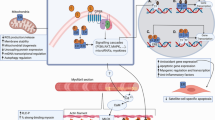Summary
Primary cultures of muscle from normal (line 412) and dystrophic (line 413) chick embryos were exposed to corticosterone-21-acetate (C-21-A) or sodium ibuprofen (Motrin) for 28 d after myotube formation. Ibuprofen (0.5 to 500 μg/ml) or C-21-A (0.4 to 40 μg/ml)-treated cultures were fixed and assessed semiquantitatively using phase microscopy. On this basis, ibuprofen (50 μg/ml) and C-21-A (40 μg/ml) seemed to be effective in maintaining both normal and dystrophic muscle cultures. Using ibuprofen and C-21-A at these concentrations, experiments were repeated and analyzed quantitatively. Ibuprofen maintained culture viability (up to 68% more myotubes than untreated controls) but had no significant effect on the number of striated cells. C-21-A effectively maintained culture viability (up to 73% increase) and strongly promoted the formation of striated cells in these cultures (up to a sixfold increase). Both normal and dystrophic cultures were affected similarly by these agents, but the dystrophic cultures showed more consistent if not more extensive improvements in the parameters examined here. Thus, it seems that ibuprofen and C-21-A may affect both normal and dystrophic muscle directly to maintain survival and even promote differentiation.
Similar content being viewed by others
References
Askanas, V.; Hee, D. Histochemical and tissue culture studies of dystrophic and experimentally denervated animal muscle. J. Neuropath. Exp. Neurol. 33:541–551; 1974.
Askanas, V.; Shafiq, S. A.; Milhorat, A. T. Normal and dystrophic chicken muscle at successive stages in tissue culture. Arch. Neurol. 24:259–265; 1971.
Beck, J. C.; McGarry, E. E. Physiological importance of cortisol. Br. Med. Bull. 18:134–140; 1962.
Bulien, D.; Hughes, B. The effect of indomethacin on serum and skeletal muscle enzyme activities of dystrophic hamsters. Biochem. Pharmacol. 15:981–983; 1976.
Cardinet, G. H.; Freedland, R. A.; Tyler, W. S., et al. Morphologic, histochemical, and quantitative enzyme study of hereditary avian muscular dystrophy. Am J. Vet. Res. 33:1671–1684; 1972.
Chen T. R. In situ detection of mycoplasma contamination in cell cultures by fluorescent Hoechst 33258 stain. Exp. Cell Res. 104:255–262; 1977.
Drachman, D. B.; Toyka, K. V.; Myer, E. Prednisone in Duchenne muscular dystrophy. Lancet 2:1409–1412; 1974.
Entrikin, R. K.; Patterson, G. T.; Wilson, B. W. Drug evaluation in muscular dystrophy of the chicken. Muscle Nerve 5:321–327; 1982.
Entrikin, R. K.; Patterson, C. T.; Wilson, B. W. Drugs in muscular dystrophy of the chicken: corticosterone-21-acetate. Muscle Nerve 7:130–136; 1984.
Entrikin, R. K.; Swanson, K. L.; Weidoff, P. M., et al. Avian muscular dystrophy—functional and biochemical improvement with diphenylhydantoin. Science 195:873–875; 1977.
Gryglewski, R. J. Effects of anti-inflammatory steroids on the arachidonic acid cascade. In: Weissman, G.; Paoletti, R.; Samuelsson, B., eds. Advances in inflammation research, vol 1. New York: Raven Press; 1979:505–521.
Hudecki, M. S.; Pollina, C. M.; Heffner, R. R., et al. Enhanced functional ability in drug-treated dystrophic chickens: Trial results with indomethacin, diphenylhydantoin, and prednisolone. Exp. Neurol. 73:173–185; 1981.
Julian, J. A.; Chytil, F. A two-step mechanism for the regulation of tryptophan pyrrolase. Biochem. Biophys. Res. Comm. 34:734–739; 1969.
Karpati, G.; Carpenter, S.; Melmed, C. et al. Experimental ischemic myopathy. J. Neurol. Sci. 23:129–161; 1974.
Kobayashi, T.; Tsukagoshi, H.; Shimizu, Y.. Trophic effects of sympathetic ganglia on normal and dystrophic chicken skeletal muscles in tissue culture. Exp. Neurol. 77:241–253; 1982.
Konigsberg, I. R. Skeletal myoblasts in culture. Methods Enzymol. 58:511–527; 1979.
Lewis, D. A.; Symons, A. M.; Ancill, R. J. The stabilization-lysis action of anti-inflammatory steroids on lysosomes. J. Pharm. Pharmac. 22:902–908; 1970.
Lucy, J. A. Lysosomal membranes. In: Dingle, J. T.; Fell, H. B., eds. Lysosomes in biology and pathology, vol 2. Amsterdam: North-Holland; 1969;313–341.
Mendell, J. R.; Sahenk, Z.; Silverman, L. M. Relationship of biogenic amines to Duchenne muscular dystrophy. In: Rowland, L. P., ed. Pathogenesis of human muscular dystrophies. Amsterdam: Elsevier North Holland 1976:678–684.
Mokri, B.; Engel, A. G. Duchenne dystrophy: Electron microscope findings pointing to a basic or early abnormality in the plasma membrane of the muscle fiber. Neurol. 25:1111–1120; 1975.
Owens, K. Biochemical studies of dystrophy in the young chicken: Lysosomal and sarcolemmal enzymes. Ann. NY Acad. Sci. 317:247–262; 1979.
Rodemann, H. P.; Goldberg, A. L. Arachidonic acid, prostaglandin E2 and F2 influence rates of protein turnover in skeletal and cardiac muscle. J. Biol. Chem. 257:1632–1638; 1982.
Rodemann, H. P.; Waxman, L.; Goldberg, A. L. The stimulation of protein degradation in muscle by Ca2+ is mediated by prostaglandin E2 and and does not require the calcium-activated protease. J. Biol. Chem. 257:8716–8723; 1982.
Santidrian, S.; Marchon, P.; Zhao, X. H., et al. Effect of corticosterone on rate of myofibrillar protein breakdown in adult male rats. Growth 45:342–356; 1981.
Siegel, I. M.; Miller, J. E.; Ray, R. D. Failure of corticosteroid in the treatment of Duchenne (pseudo-hypertrophic) muscular dystrophy. Illinois Med. J. 145:32–36; 1974.
Sugita, H.; Ishiura, S.; Suzuki, K., et al. Ca-activated neutral protease and its inhibitors: in vitro effect on intact myofibrils. Muscle Nerve 3:335–339; 1980.
Tomkins, G. M.; Gelehrter, T. D.; Granner, D., et al. Control of specific gene expression in higher organisms. Science 166:1474–1477; 1969.
West, W. T.; Meier, H.; Hoag, W. G. Hereditary mouse muscular dystrophy with particular emphasis on pathogenesis and attempts at therapy. Ann. NY Acad. Sci. 138:4–18; 1966.
Wilson, D. R.; Honrath, U.; Sonnenberg, H. Furosemide action on collecting ducts: effect of prostaglandin synthesis inhibition. Am. J. Physiol. 244:F666–673; 1983.
Witkowski, J. A., Diseased muscle cells in culture. Biol. Rev. 52:431–476; 1977.
Wolitzky, B. A.; Segal, H. L.; Hudecki, M. S. Similarities in protein synthesis and degradation in normal and dystrophic muscle cultures. Exp. Cell Res. 137:295–299; 1972.
Young, R. B.; McConnell, D. G.; Suelter, C. H., et al., Normal and dystrophic embryonic chicken pectoralis muscle cultures: I. Cell differentiation, protein synthesis, and enzyme levels. Muscle Nerve 4:117–124; 1981.
Author information
Authors and Affiliations
Rights and permissions
About this article
Cite this article
Walter, R.J., Hyun, J. Increased viability and differentiation of normal and dystrophic striated muscle in vitro. In Vitro Cell Dev Biol 22, 535–541 (1986). https://doi.org/10.1007/BF02621140
Received:
Accepted:
Issue Date:
DOI: https://doi.org/10.1007/BF02621140




